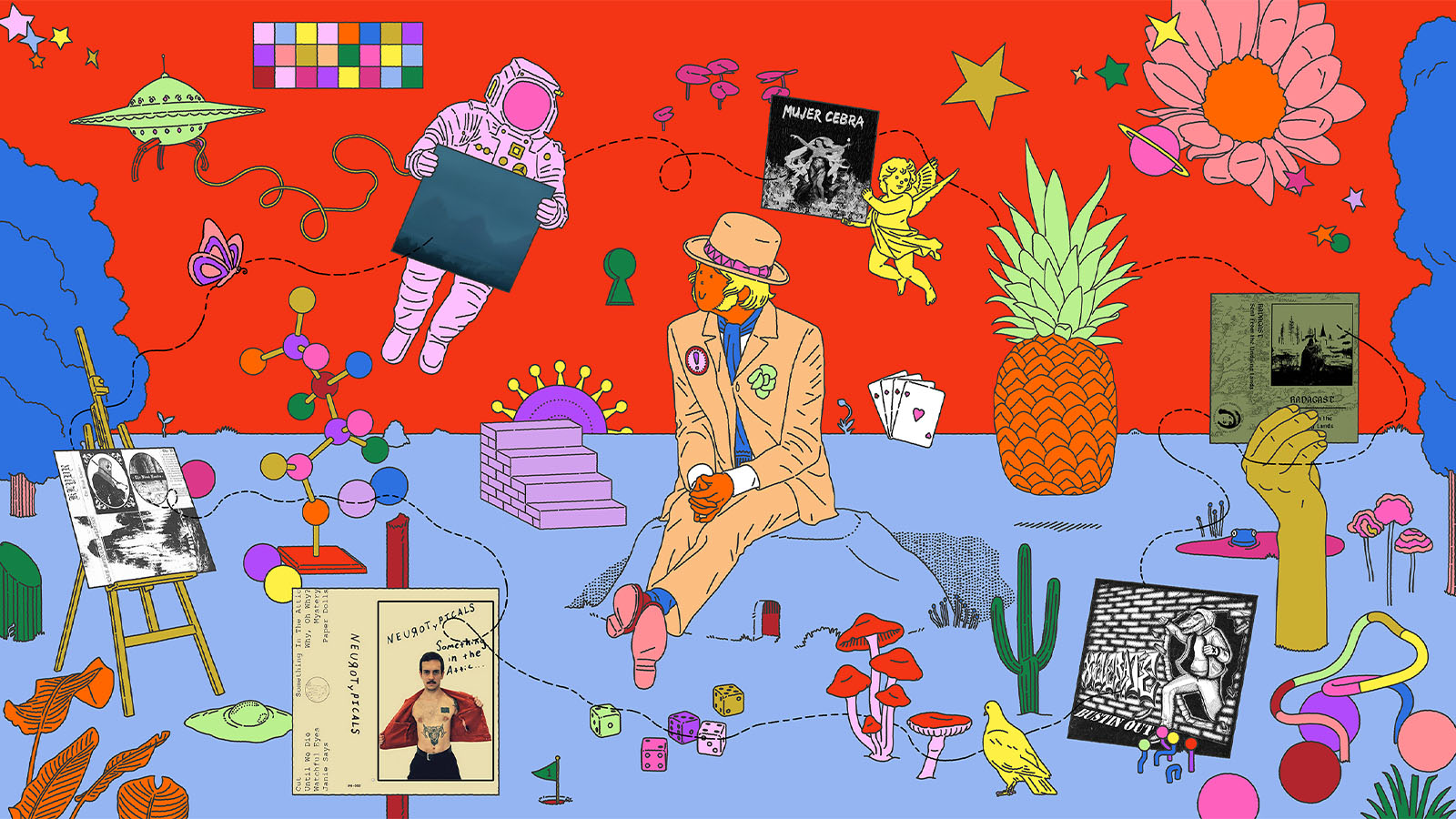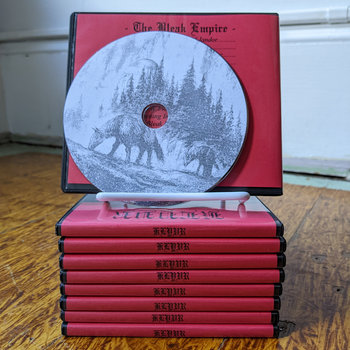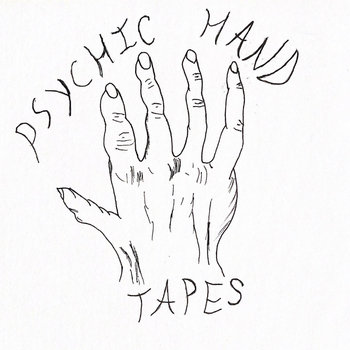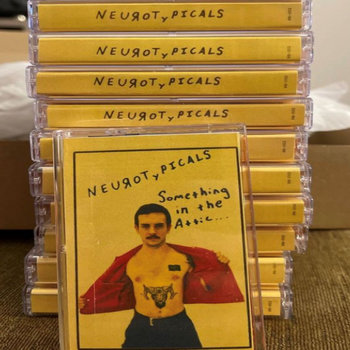
Is it an insult to say that you fall asleep listening to a record? I know that there are some artists who explicitly state that they make music for that purpose, but if they don’t present their work that way, I don’t want to imply anything negative. I’ve been falling asleep listening to something or other since my teenage years. For the past few weeks, my end-of-day record has pretty consistently been our first featured album this month. Please keep in mind, though, that I highly recommend also listening to it when you’re fully awake.
Radagast
Sent From the Undying Lands




Cassette


There are a few records that I automatically go to when I want to listen to something relaxing, calming, and peaceful. Over the past couple of months, the latest from Leipzig’s Radagast has climbed to the top of that list. It says “dungeon synth” on the wrapper—named for a Tolkien wizard and sporting a high-contrast picture of a cloaked figure and a tower on the cover—but the music is high-quality, Berlin-school-inspired synth music along the lines of contemporaries like San Francisco’s Jenzeits or Kurt Stenzel’s Jodorowsky’s Dune soundtrack. Starting with repetitive loops of glittering arpeggios and adding ghostly melodies, Radagast creates eerie soundscapes that are simultaneously tranquil and uncanny. On “Death is just another path,” for example, a high-pitched cascade of tones flows over an ominous trembling bassline while robotic voices sound out incoherently just on the edges of the mix. Sent from the Undying Lands is an enthralling journey.
Along with the ongoing explosion of the dungeon synth subgenre, we’re seeing a correlated rise in the use of the #fantasy ambient tag. I’m not sure if this is a way to further separate works from the black metal roots of dungeon synth, or just another way for people to find this specific type of music, but whatever the reason, I’m 100 percent on board with it.
Klyvr
The Bleak Empire




Compact Disc (CD), Cassette




In order to discuss Klyvr, it’s necessary to acknowledge all of the work of the person behind the project: Myst, proprietor of Lost Armor Records and limited-edition CD-R label Wizard Discs. Myst is also an incredibly prolific musician, releasing mainly as Coniferous Myst, but also as Dragon Spell and Klyvr. The Bleak Empire is true to its name: a cold, sparse, lo-fi dungeon synth experience. Purportedly recorded in a single take, we’re told, to capture the “authenticity of the performance,” The Bleak Empire evokes harsh, snow-covered mountain crags, a lone trumpeter standing on the edge of an abyss sending melodies into the chasm to echo from the rocks below. Despite the album’s stark minimalism, it’s quite engaging—even, dare I say, cozy at times. Check out “Silent Snowstorms of Kator,” a placid lament conjuring imagery of falling snows viewed from fireside in a shelter. This is another entry in Myst’s impressive discography, work that despite its minimalism calls forth visions of entire new worlds.
Remember when we mentioned dungeon synth’s black metal roots above? Even though you won’t really hear any black metal on the Klyvr album, its roots are exposed through the artist’s use of the #raw black metal tag. Let’s dig deeper to find something more in line with our expectations.
Winter Lantern
Hexen Lied


There’s a part near the end of the six-minute “Torturous Howls Beneath Blood Banners,” the second track on this compilation of tracks from North Carolina vampiric black metal band Winter Lantern, where the furious double bass blastbeats and tremolo picking subsides and the band kicks into a slow, lurching riff. It’s kind of shocking, the transition from breakneck frenzy to this more deliberate tempo. If you know how black metal works, you know it’s all going to go full speed again—and it does—but in that moment, the vampire metaphor in the music becomes clear. The lore tells us that the vampire is a creature who lies in wait until the need to strike becomes overwhelming. Then, there’s a brutal efficiency to the speed and strength on display as the victim is dispatched. Winter Lantern, intentionally or not, “get” this. Most of the “gothic” trappings of the sub-sub-sub genre of “vampiric black metal” are absent here (there are, for example, no orchestral parts). Winter Lantern captures the essential nature of the beast. Most of the tracks on this compilation are furiously fast overdriven blasts of otherworldly fury, but there are (admittedly rare) times when the vampire needs to slow down. The barely-contained power is always there, though, waiting just below the surface.
I’ll be honest…when I think of #Greensboro, North Carolina, the first thing I think of is professional wrestling, given that town’s near-mythical status in the history of that great sport. I rarely think of vampiric black metal or smooth modern R&B, but as we’re learning today, that town has both!
Daniel Vaughan
Lofi Songs


This collection of soulful R&B tracks is understated and refined—even elegant. Maybe it’s just the trappings of the genre that I’ve become accustomed to, but it’s easy to imagine a video to any of these songs featuring well-dressed, attractive people partying in a hotel or restaurant I could never afford. Daniel Vaughan taps into the tried and true ‘90s R&B formula here, with stuttering, booming drum machine beats providing the foundation for his songs. But this isn’t strictly a copy of that formula with no updates. First, these songs are shorter, with lengths closer to those of 21st century pop. Some, like the 53-second “Until You Know Me,” show up, make an impact and fade away before you realize it, leaving a memory that lasts longer than the song itself. It’s a quality that Vaughn has expertly infused into this entire album. Using synths, sound effects, a clean electric guitar that flutters in and out of these six songs like a butterfly, and Vaughan’s rich, hypnotic voice, Lofi Songs has a dreamlike and irresistible quality.
Even though most of us who enjoy pop music (and it’s all pop music, friends) have at least a small sense of the importance of Memphis’s Sun Records, the depth and breadth of that label’s catalog is truly staggering. Sun is probably best known for country and rockabilly sounds, but they have a deep catalog of blues and #R&B/Soul as well.
Frank Ballard
Rhythm Blues Party (Remastered 2022)
Originally released in 1964, Frank Ballard’s Rhythm Blues Party does exactly what it says on the tin. This is a party on record with tracks ranging from upbeat numbers like the Little Richard/Esquerita-style “Do You Really Love Me” to the slow-dance ready “After Hours,” a song that the album’s notes describe as “sultry.” There’s even a bit of proto-funk with “Rollin’ In,” a song featuring strong influences from Ballard’s labelmates Pinetop Perkins (in the song’s acrobatic piano runs) and Rufus Thomas (in the song’s bouncy bassline). This newly remastered edition also highlights the musicianship of Ballard’s backing band, Memphis’s Phillip Reynolds Band. The guitar in “Is There Anybody Here” and “I Just Can’t Help It” leaps out of the mix, while the vocals on “Something In My Mind” have a slight echo that disappears the louder Ballard sings. It’s subtle, but it’s a fascinating insight into mid-’60s recording techniques. Although Ballard may not be one of the big names in mid-20th century R&B, this album definitely stands strong nearly 60 years after its release.
Because it’s based in Memphis, it’s hard to tell the #Jackson tag used by Sun Records refers to Jackson, Tennessee, a town a 2 hour drive up Interstate 40 from Memphis, or the better-known Jackson, Mississippi. Regardless, the latter Jackson is where we’re headed next.
Neurotypicals
Something in the Attic



Cassette

Beginning with a spindly, clean electric guitar melody that sounds like a Pylon record played on the wrong speed, the latest release from Neurotypicals soon explodes into a ball of nervous energy. Reaching back to grab influence from the ancient texts of Devo and The Rezillos, Neurotypicals have crafted a sound that is hectic, bombastic, and (above all else) infectious (but, you know, in a good way). It’s a sound that fits in alongside contemporary acts like Straw Man Army, or maybe early xbxrx (but not quite as “noisy”). The mix is blown out and distorted, and whether this is a stylistic choice or just a consequence of the way this recording was made, it doesn’t matter because it’s the perfect way to hear this music. There’s so much frantic energy behind these songs it feels like they’re being crammed through the speakers and into your ears. The album’s centerpiece is the four-minute-plus “Janie Says,” the only track that breaks the two-minute mark. It’s perfectly sequenced between the neo-rockabilly “Watchful Eyes” and the explosive “Something in the Attic,” the latter of which has some pretty spectacular instrumental acrobatics (briefly) on display. Do you like fast, loud punk rock music? Then you’re gonna like this.
Although the Neurotypicals obviously take inspiration in ’80s #hardcore (not the techno kind, mind you, although there’s plenty of that to be found in the tag, if that’s what you’re looking for), that’s a different hardcore sound than what Florida, still the current epicenter of American hardcore in my opinion, is serving up. Let’s head a little further south and check in on some new Florida hardcore.
Xcelerate
Bustin’ Out



Vinyl LP

Okay, first things first: I know you aren’t supposed to judge a record by its cover, but we all do it and, well, just look at this thing! The third issue of the magazine Demystification (Spring 2021) had an excellent article about the history of the “hooded mosher” in hardcore graphic design, but not once during that article did anyone stop to ask “What if the hooded mosher was also an alligator?” The answer, of course, is that it would be the greatest thing in the world, but nobody knew it until Xcelerate put it right in front of our faces. It would be a tragedy if the music on this record failed to live up to the majesty of that cover, but thankfully, it does. This is furious, straightforward, ‘80s-style hardcore with tempos ranging from the mid-paced stomp of “When Does It End?” to the raging “Bad Beat.” The 52-second “Just Another Fool” manages to pack in both a really fast part, an anthemic solo and a pit-ready two-step breakdown, a phenomenal achievement for less than a minute. The whole album, as you would expect, is over in seven minutes, but they’re seven perfect minutes, and that’s what matters.
Xcelerate and their gator-headed mosh mascot are based in #West Palm Beach, a city that also brings us some ominous drone-based ambient music.
Theum Beance
Field Recordings from the Otherlands


Occasionally, a viral video will surface of a popular song slowed down to some ridiculously low BPM that recontextualizes the work, drawing attention to elements that were hidden by the song’s proper speed. These attributes are, of course, unintentional. Pop musicians don’t write sprawling ambient drone pieces and then speed them up 600%. What Theum Beance does, though, offers a similar experience, though it’s far more satisfying because those transcendent details are actually intentional. On the expansive “Melody of the Vastness,” for example, a thudding percussive element keeps a languid pace behind the piece’s rising and falling synth drones, evoking the footfalls of some ancient giant shrouded by mists and distance. Are the footsteps getting closer or moving away? It’s hard to tell, but they’re at the center of the experience. As additional sounds are added—hints of melody, the occasional chime, voices that ring our in chorus, sounding almost human—the experience evolves, creating vast fantasy landscapes in the mind. Each of the pieces here offer a new world to discover, a new collection of experiences waiting to slowly reveal themselves.
The #nostalgic tag is a weird one, because it’s mostly focused on music that isn’t from a time for which the listener may have nostalgia, but it sounds like it might be. It’s more about the feeling created in the listener’s mind than the actual sounds on the record. Regardless, our next featured artist fits right into it.
Mi Lado Ausente
Triángulo Lunar


Sometimes you have to wonder if the pop musicians of the ‘80s knew they were onto something that would last (to date) 40 years into the future. Think about it this way; when they were making their music, pulling influences from 40 years in the past would have resulted in a whole lot of big band and Western swing music. Whatever mystical formula they found, though, completely works. It’s why we have artists like Argentina’s Mi Lado Ausente. Of course they combine the bright poppy synths of New Order with the throbbing basslines of Bauhaus (and, by extension, Love and Rockets)—that’s just good sense. But you can also hear some lesser known influences at work here; a bit of Heaven 17, Peter Schilling, and the darker parts of the works of The Human League pop up here and there. There are also elements of late ‘80s EBM and industrial in the driving, throbbing low-end of “Operación.” It’s not all moody and dismal, though. “Acedia” kicks off with a bright acoustic guitar and supporting shimmery electric guitar solo runs. It’s a song you could swear you heard at a party when you were in college in ‘85, even if you never went to college and weren’t even born then.
Located on the coast of northern Argentina, #Mar Del Plata is primarily known as a beachside resort town. It’s where we’ll end our trip this month.
Mujer Cebra
Mujer Cebra


Sometimes a guitar sound gets strongly associated with a particular artist. Nobody owns a sound, though, so it’s always interesting when it crops up in unexpected places. For instance, Mujer Cebra have dialed in the sound of Robert Smith’s guitar. That’s not to say their self-titled album is in any way a blatant homage to The Cure; it’s not. It’s just that the tone of Santiago Rocca’s guitar will be instantly familiar to many listeners. What’s more important, though, is how that sound is used—here, it’s to remarkable effect. These 10 tracks hit several of the post-punk sonic touchstones; a little bit of shoegaze, a little bit of Midwest emo, a little bit of early 20th century “indie,” all hung on some killer pop hooks. The transition from verse to chorus on “Adrenalina,” for example is positively anthemic. The musicianship here is incredibly tight, as well. Bassist Gonzalo Muhape is strong in the mix, and his solid low-end really holds these songs together. Overall, this is a strong debut statement, one that holds up to many repeated listenings.
And that’s another trip, spanning the distance from the Undying Lands (wherever they may be) to the Argentinian beaches (which are a little easier to find). Thanks for taking this journey with me. We’ll be off on another one soon!







